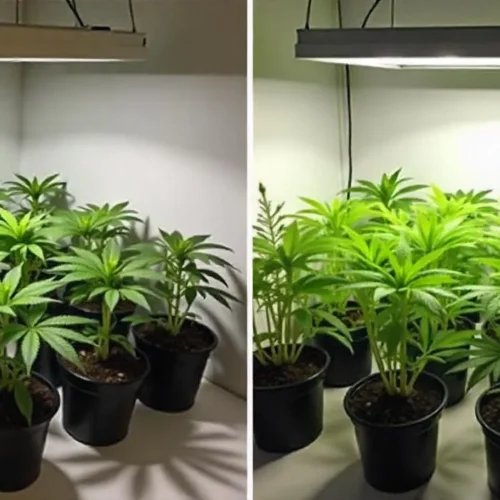Crossbreeding cannabis is a fascinating and rewarding process that allows you to create new strains with unique characteristics. Whether you’re looking to develop a strain with specific effects, flavors, or growing traits, how to crossbreed cannabis is the key to revealing endless possibilities. This comprehensive guide will walk you through the process, providing valuable insights and tips to help you succeed in your breeding endeavors.
The Basics of Cannabis Genetics
Before diving into the practical steps of crossbreeding, it’s essential to understand the basics of cannabis genetics. Cannabis plants are dioecious, meaning they have distinct male and female plants. The male plants produce pollen, while the female plants produce flowers (buds). The process of crossbreeding involves transferring pollen from a male plant to a female plant to create seeds that carry genetic traits from both parents.
Recommended Strains
Fat Bastard
 THC: 30% - 38%
THC: 30% - 38% Type of seed: Feminized
Type of seed: Feminized Phenotype: Mostly Hybrid
Phenotype: Mostly Hybrid Day to flower: 8 - 10 weeks
Day to flower: 8 - 10 weeks
Fat Bastard Auto
 THC: 30% - 38%
THC: 30% - 38% Type of seed: Autoflowering
Type of seed: Autoflowering Phenotype: Mostly Hybrid
Phenotype: Mostly Hybrid Day to flower: 8 - 10 weeks
Day to flower: 8 - 10 weeks
Cannabis genetics are responsible for the wide variety of strains available today. These genetics determine everything from the plant’s growth patterns to its cannabinoid and terpene profiles. By carefully selecting parent plants with desirable traits, you can create new strains that exhibit those characteristics.
Dominant and Recessive Traits
When crossbreeding cannabis, it’s important to understand the concept of dominant and recessive traits. Dominant traits are more likely to be expressed in the offspring, while recessive traits may be hidden unless both parents carry the recessive gene. For instance, if you’re trying to breed a strain with a high THC content, you’ll want to select parent plants that both exhibit this trait dominantly. Likewise, when aiming for specific flavors or colors in your strain, knowing which traits are dominant can help guide your selection process.
Phenotypes and Genotypes
Another critical concept in cannabis genetics is the difference between phenotypes and genotypes. The genotype refers to the genetic makeup of the plant, while the phenotype is the physical expression of those genes. When you crossbreed cannabis, the offspring will inherit a mix of genes from both parents, leading to various phenotypes. These phenotypes can vary widely, even among seeds from the same cross, which is why selective breeding over several generations is often necessary to stabilize a new strain. This variability allows breeders to explore and select the most desirable expressions, whether they relate to potency, aroma, or resilience.
Promos & Deals
Selecting Parent Plants for Crossbreeding
The success of your crossbreeding project largely depends on the parent plants you choose. Selecting the right parents is crucial for achieving the desired traits in your new strain. Here’s how to go about selecting the best male and female plants for your breeding project.

Choosing a Female Plant
The female plant you choose will be the mother of your new strain, so it’s essential to select a plant that exhibits the traits you want to pass on to the offspring. Look for a female plant with strong, healthy growth, a desirable cannabinoid profile (such as high THC or CBD content), and a terpene profile that aligns with your goals. Additionally, consider the plant’s resistance to pests and diseases, as these traits can also be passed on to the offspring. For example, if you’re breeding for medicinal purposes, selecting a female with a balanced cannabinoid profile and proven therapeutic benefits is crucial.
Selecting a Male Plant
The male plant provides the pollen that will fertilize the female plant, so selecting a high-quality male is just as important as choosing the right female. Look for a male plant that has strong growth, produces abundant pollen, and exhibits desirable traits that complement the female plant. It’s also worth noting that male plants can influence the offspring’s flowering time, yield, and overall growth patterns, so choose a male that aligns with your goals for the new strain. In some cases, breeders may also seek males with specific terpene profiles to enhance the aroma and flavor of the resulting strain.
The Crossbreeding Process: Step-by-Step Guide
Now that you’ve selected your parent plants, it’s time to begin the crossbreeding process. This section will guide you through each step, from isolating your plants to collecting and applying pollen.
Step 1: Isolate Your Plants
To prevent unwanted cross-pollination, it’s crucial to isolate your male and female plants from each other and any other cannabis plants in your grow space. This can be done by placing the male plant in a separate grow room or using a grow tent with a filtration system to keep the pollen contained. Proper isolation ensures that the pollen from your selected male only reaches the intended female, preserving the integrity of your crossbreeding efforts.
Step 2: Collect Pollen from the Male Plant
Once the male plant begins to produce pollen, you’ll need to collect it carefully. The pollen sacs will start to open, releasing pollen into the air. To collect the pollen, place a small bag or container under the sacs and gently tap the plant to release the pollen. Be sure to handle the pollen carefully, as it can easily be carried by the wind or on your clothes. Some breeders even use specific techniques to dry and store pollen for later use, ensuring that it’s viable when needed.
Step 3: Pollinate the Female Plant
With the pollen collected, it’s time to pollinate the female plant. This step is crucial in the crossbreeding process, as it determines the genetic makeup of the seeds. To pollinate the female, use a small brush or cotton swab to apply the pollen directly to the pistils of the female flowers. It’s best to do this in a controlled environment to prevent accidental cross-pollination with other plants. Some breeders may choose to pollinate only select branches to produce a smaller batch of seeds, allowing the rest of the plant to continue flowering normally.
Step 4: Wait for Seed Development
After pollination, the female plant will begin to produce seeds. This process can take several weeks, during which you’ll need to continue caring for the plant as usual. The seeds will mature within the buds, and you’ll notice the flowers starting to swell as the seeds develop. It’s important to monitor the plant closely during this period, ensuring that it receives the right nutrients and care to produce healthy, viable seeds.
Step 5: Harvest and Collect Seeds
Once the seeds have matured, it’s time to harvest the plant and collect the seeds. Carefully remove the buds and allow them to dry. After drying, you can break apart the buds to collect the seeds. These seeds carry the genetic traits of both parent plants and are the foundation of your new strain. Proper storage of these seeds is essential to maintain their viability for future growing seasons.

Stabilizing Your New Strain
After successfully crossbreeding your cannabis plants and collecting the seeds, the next step is to stabilize the new strain. Stabilization involves growing multiple generations of the new strain to ensure that the desired traits are consistently expressed.
The Importance of Selective Breeding
Selective breeding is the process of choosing the best plants from each generation to continue breeding. This step is crucial for stabilizing your new strain, as it helps to eliminate unwanted traits and reinforce the desirable ones. Over several generations, you can create a strain that consistently expresses the traits you want, such as potency, flavor, and growth patterns. Selective breeding is a meticulous process that requires patience, but it’s essential for creating a stable and reliable strain that meets your goals.
Backcrossing for Stability
One technique often used in stabilizing a new strain is backcrossing. This involves crossing the offspring with one of the original parent plants to reinforce specific traits. For example, if you want to enhance the THC content of your new strain, you might backcross it with the parent plant that had the highest THC levels. Backcrossing can help to stabilize the strain more quickly, reducing the number of generations needed to achieve consistency. However, it’s important to carefully monitor each generation to ensure that the desired traits are being reinforced rather than diluted.

Challenges in Crossbreeding Cannabis and How to Overcome Them
Crossbreeding cannabis can be a rewarding process, but it’s not without its challenges. These challenges and how to overcome them is key to success.
Challenge 1: Unwanted Traits in Offspring
One of the most common challenges in crossbreeding is the appearance of unwanted traits in the offspring. These can include lower potency, undesirable flavors, or poor growth patterns. To overcome this challenge, focus on selective breeding. By choosing only the plants that exhibit the desired traits for further breeding, you can gradually eliminate unwanted characteristics. Additionally, documenting each generation’s traits can help you track progress and make informed decisions in subsequent breeding efforts.
Challenge 2: Hermaphroditism
Hermaphroditism, where a plant develops both male and female flowers, is another challenge in crossbreeding. This can lead to self-pollination and the production of seeds that carry unwanted traits. To prevent hermaphroditism, avoid stress factors like light leaks, temperature fluctuations, and nutrient imbalances that can trigger the development of male flowers on female plants. If you identify a hermaphroditic plant, remove it from your breeding program to maintain the integrity of your strain. Additionally, selecting parents with a stable history of not developing hermaphroditic traits can reduce the likelihood of this issue.
Challenge 3: Inconsistent Phenotypes
Inconsistent phenotypes, where the offspring exhibit a wide range of traits, can be frustrating for breeders. This variability is common in the early generations of crossbreeding. Overcome this challenge by growing large batches of seeds and selecting the plants that best represent your desired traits for further breeding. Consistency will improve over successive generations as you stabilize the strain. It’s also helpful to work with multiple lines of the same cross, comparing and selecting the best traits from each line.
Advanced Crossbreeding Techniques for Cannabis
For those looking to take their breeding efforts to the next level, several advanced techniques can be employed to create truly unique strains.
Polyhybrid Crossbreeding
Polyhybrid crossbreeding involves crossing two hybrid strains, each with its unique genetic background. This technique can result in a wide variety of phenotypes, offering a greater potential for discovering new and exciting traits. However, it also requires careful selection and stabilization over several generations to achieve consistent results. Polyhybrid breeding is particularly useful for breeders aiming to combine complex traits such as specific cannabinoid profiles with distinct terpene combinations.
Marker-Assisted Selection
Marker-assisted selection is a more advanced breeding technique that uses genetic markers to identify specific traits in the plants. This method allows breeders to select plants based on their genetic potential rather than just their physical appearance. While this technique requires access to genetic testing facilities, it can significantly speed up the breeding process and improve the accuracy of trait selection. Marker-assisted selection is especially valuable for breeders targeting specific medicinal properties or resistance to environmental stressors.
Epigenetic Breeding
Epigenetics, the study of changes in gene expression that do not involve alterations to the DNA sequence, is an emerging field in cannabis breeding. Epigenetic breeding involves manipulating environmental factors, such as light and temperature, to influence gene expression and produce desired traits. While still in its early stages, this technique has the potential to revolutionize cannabis breeding by allowing breeders to unlock new traits without traditional crossbreeding methods. For instance, by altering the growing environment, breeders may be able to enhance certain cannabinoid or terpene expressions, leading to unique strain profiles.
Legal Considerations and Ethical Breeding Practices
As cannabis continues to gain legal status in various parts of the world, it’s important to understand the legal considerations and ethical practices involved in crossbreeding cannabis.
Local Laws
Before embarking on a crossbreeding project, ensure that you are fully aware of the local laws and regulations surrounding cannabis cultivation and breeding. In some regions, breeding cannabis may be restricted or require specific licenses. Always adhere to local laws to avoid legal complications and ensure that your breeding efforts are conducted responsibly. Additionally, staying informed about changes in legislation can help you navigate the legal landscape and protect your breeding work.
Ethical Breeding Practices
Ethical breeding practices are essential for maintaining the integrity of the cannabis gene pool and ensuring the sustainability of the industry. This includes being transparent about the lineage of your strains, avoiding the propagation of harmful traits, and respecting the intellectual property rights of other breeders. By adhering to ethical practices, you contribute to the growth of a responsible and sustainable cannabis industry. Additionally, sharing your breeding successes and challenges with the community can foster collaboration and innovation within the industry.
FAQs About How to Crossbreed Cannabis
What is the goal of crossbreeding cannabis?
The goal of crossbreeding cannabis is to create new strains that exhibit specific desirable traits, such as higher potency, unique flavors, or improved growth characteristics. By combining the genetics of two parent plants, breeders can develop strains that offer the best qualities of both.
How long does it take to stabilize a new cannabis strain?
Stabilizing a new cannabis strain typically takes several generations of selective breeding. Depending on the complexity of the traits being selected, this process can take anywhere from a few years to several years. Patience and careful selection are key to achieving a stable strain.
Can I crossbreed cannabis plants indoors?
Yes, crossbreeding cannabis plants can be done indoors. In fact, many breeders prefer indoor environments because they offer greater control over environmental factors such as light, temperature, and humidity. Indoor crossbreeding also allows for better isolation of plants to prevent unwanted cross-pollination.
What are the risks of crossbreeding cannabis?
The risks of crossbreeding cannabis include the potential for unwanted traits to emerge, such as lower potency or hermaphroditism. Additionally, crossbreeding can be time-consuming and may require several generations to achieve the desired results. However, with careful planning and selection, these risks can be minimized.
Is it possible to patent a new cannabis strain?
Yes, it is possible to patent a new cannabis strain in some regions. However, the process can be complex and may require detailed documentation of the strain’s lineage and unique characteristics. Patenting a strain can provide legal protection for your creation and prevent others from using it without permission.

















